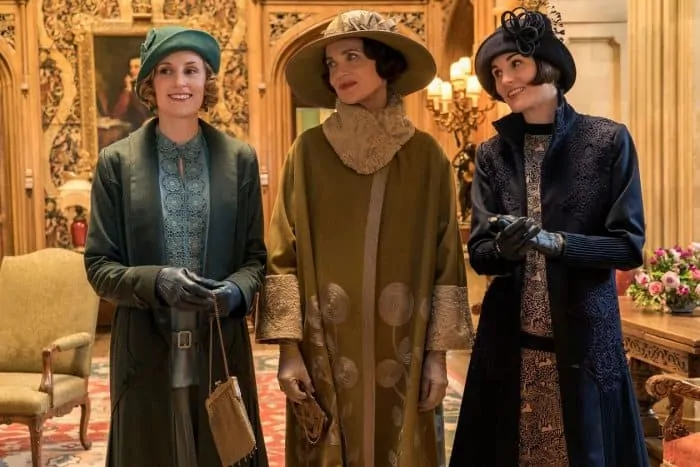From 2010 to 2015 the Downton Abbey television series fascinated American audiences. Created by Julian Fellowes, the miniseries chronicled the lives of the aristocratic Crawley family in the early 20th century, after the Great War (1914-1918) and before the Great Depression.
Downton Abbey The Movie was made for devoted fans of the television series. Attention to detail regarding historical costumes and elegant gowns, dramatic moments between family members and staff, discreet contrasts between the lives of moneyed British aristocrats and the hard-working men and women below stairs, room furnishings, horse-drawn carriages, – all are here on a much larger screen.
Getting to see the film at all seemed problematic at first. Picture came on without sound. Second try – sound came on without picture. On the third try, the movie house got it right and the happy audience settled down to enjoy the period architecture, vintage autos, sumptuous meals, and manufactured subplots designed to keep the story interesting.
Michael Engler was a good choice for director since he had directed several episodes of the tv series. Engler has spoken about the intensive process of returning audiences to a place and time they previously knew only on a much smaller screen, basically a different world.
As Engler pointed out in a recent interview, “it starts with the script and what the writer (Fellowes) had to so, which was create a structure that would be a standalone story.” Skillset needed also included Fellowes meeting the challenge of giving every character his or her own story, while keeping the main story moving forward. Fellowes and Engler seem to have achieved their goal.

Of course, there are those who wonder whether we need another two hours with the Crawley family at all. The premise for the “beautiful folly,” as salon.com calls the film, is an overnight visit by King George and Queen Mary as they tour their kingdom. Rising to this challenge are returning regulars from the miniseries — Hugh Bonneville as Lord Robert Grantham, Elizabeth McGovern as Lady Cora Grantham, Michelle Dockery as their daughter Lady Mary and Laura Carmichael as the other daughter Lady Edith.
WATCH: Downton Abbey Interview – Mrs. Patmore (Lesley Nicol)
Below the winding staircases are the household staff, minus the ever-loyal Carson (Jim Carter), who has retired but is pressed back into service. His wife Elsie (Phyllis Logan) still works for the Crawleys. Also returning are Daisy (Sophie McShera), assistant to Mrs. Patmore, and Mrs. Patmore herself (Lesley Nicol), doyenne of the kitchen.
The planned royal visit disturbs the tranquility of both aristocrats and servants. Will Downton Abbey be up to the challenge? What to do about the influx of royal staff members who insist on replacing domestic staff? Is a member of Special Branch shadowing the Irish republican who married into the family a decade earlier? What to do when a member of the king’s detective staff has to bail out a Downton Abbey domestic who is caught in the wrong sort of private club during a police raid?
A pleasant film experience, if one overlooks the rather ordinary soundtrack and the exceedingly heavy makeup worn by actors male and female, all too visible when the cameras come in for closeups.
A glossy film with beautiful cinematography, from the moment we see a train crossing the countryside carrying sacks of royal mail to the last glimpse of Maggie Smith as the indomitable grande dame of the Crawleys, scheming as always to be sure that Lord Grantham inherits the estate.
A pleasant film experience, if one overlooks the rather ordinary soundtrack and the exceedingly heavy makeup worn by actors male and female, all too visible when the cameras come in for closeups.


